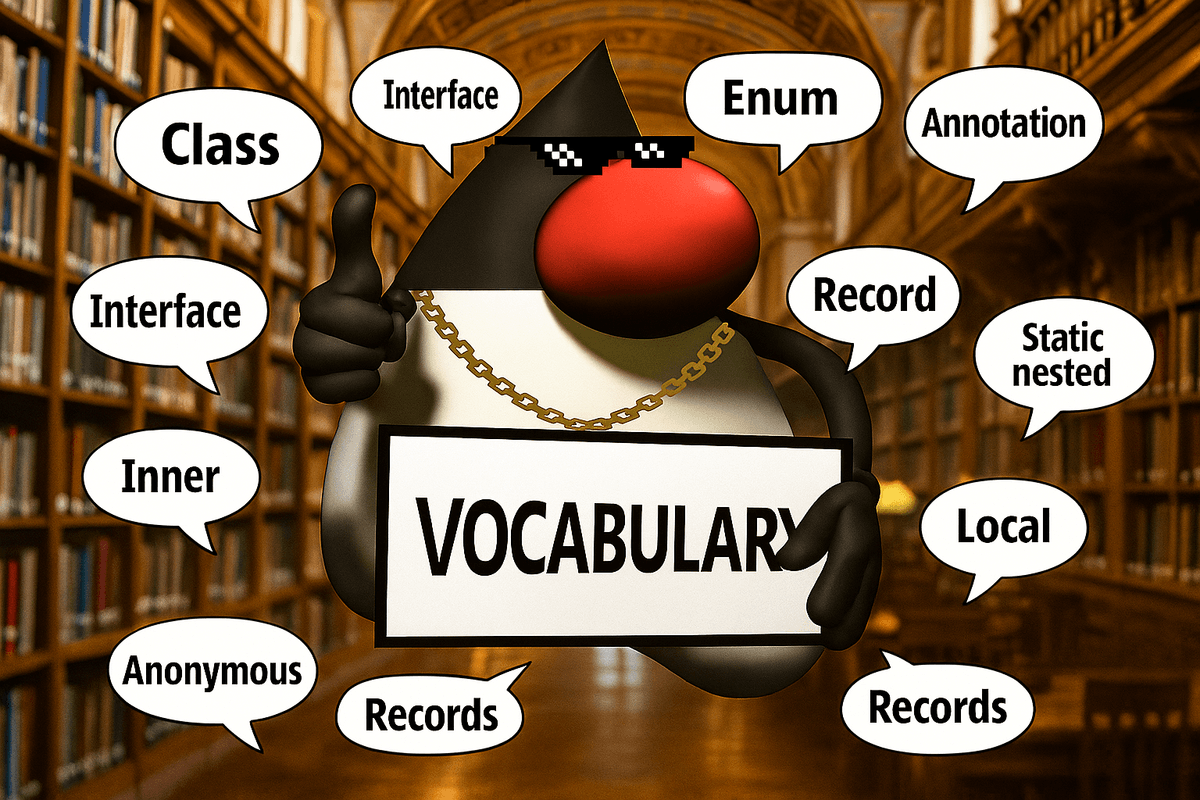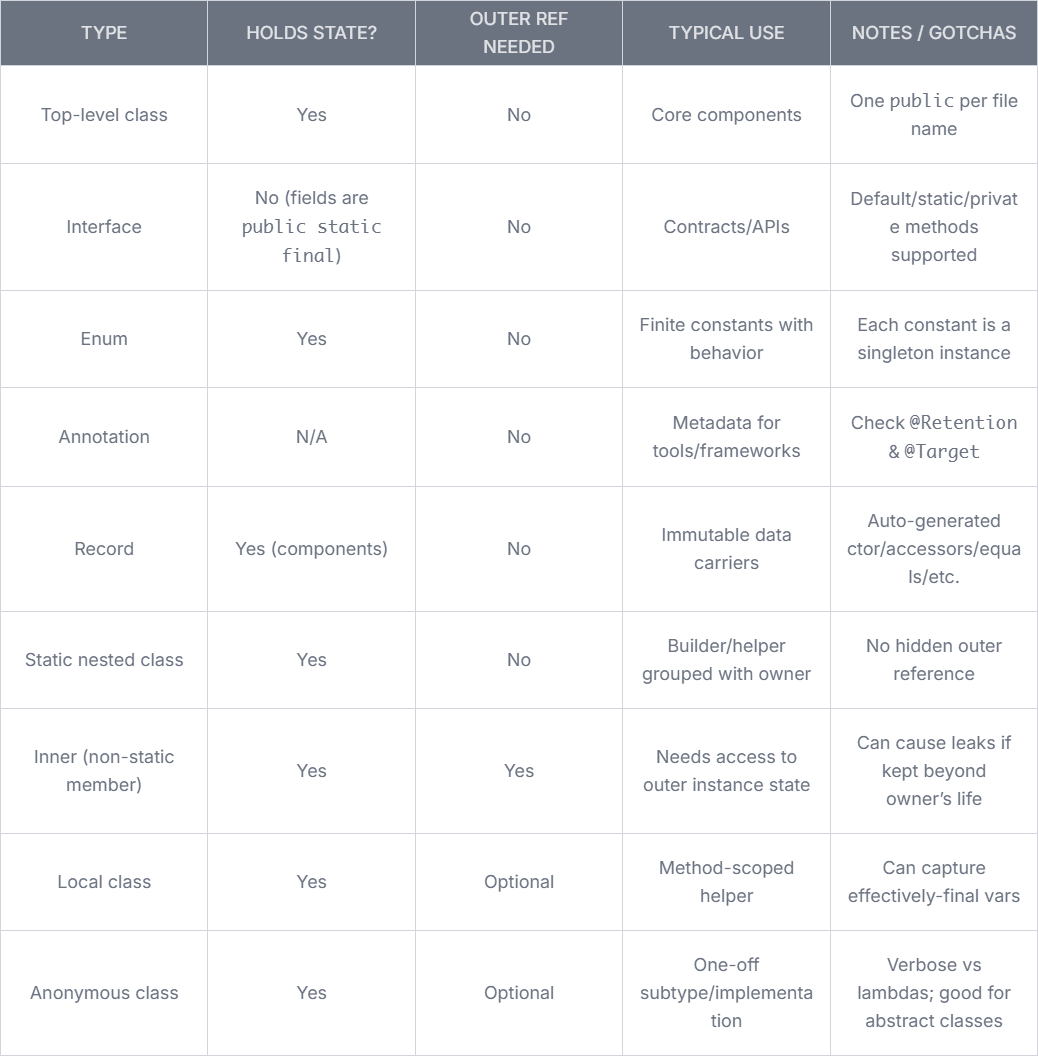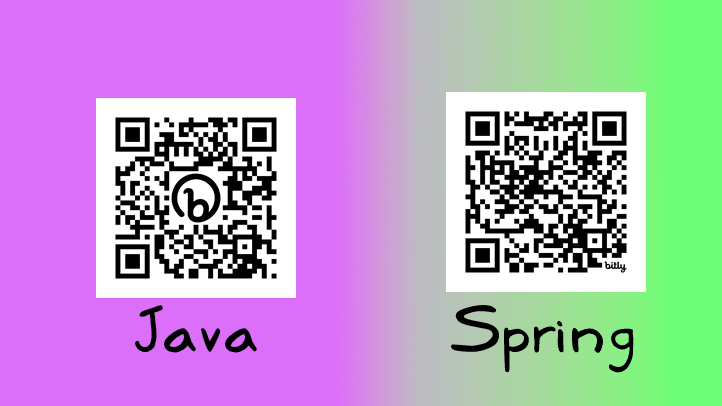
Here’s a quick, practical guide to Java’s core type kinds—what they are, when to use them, and how they differ.
🔸 CORE DEFINITIONS
▪️ Top-level class
— A class declared directly in a .java file (optionally public). The bread-and-butter building block.
▪️ Interface
— A contract of methods/consts; supports default/static/private methods. Often used for APIs and polymorphism.
▪️ Enum
— A fixed set of named constants, each a singleton instance; can have fields/methods/behavior.
▪️ Annotation
— Metadata attached to code elements; read by tools/frameworks at compile/run time.
▪️ Record
— A compact class for immutable data carriers; generates constructor, accessors, equals/hashCode/toString.
🔸 NESTED & INNER FLAVORS
▪️ Static nested class
— A static class inside another class; no implicit reference to the outer instance. Namespaced helper.
▪️ Inner (non-static member) class
— Declared as a member without static; each instance holds a reference to an outer instance.
▪️ Local class
— A named class declared inside a block/body (e.g., a method); visible only within that scope.
▪️ Anonymous class
— An inline, nameless class expression used to instantiate a one-off subtype or interface implementation.
🔸 USE CASES (WHEN TO PICK WHAT)
▪️ Top-level class
— Main components, services, controllers, entities.
▪️ Interface
— SPI/API contracts, strategy/adapter patterns, multiple inheritance of behavior (via default methods).
▪️ Enum
— Finite states (e.g., State.NEW/IN_PROGRESS/DONE), strategy via constant-specific behavior.
▪️ Annotation
— Declarative config (e.g., @Override, DI frameworks, validation, mapping).
▪️ Record
— DTOs, events, value objects; thread-safe by design (if components are).
▪️ Static nested class
— Builder, helper types, grouping “private” implementations next to their owner.
▪️ Inner class
— When the nested type must access outer instance state naturally (GUI listeners tightly bound to a widget, etc.).
▪️ Local class
— Short, named helper tied to a single method’s algorithm.
▪️ Anonymous class
— One-off callbacks before Java 8; still handy for abstract classes or SAMs needing state (though lambdas often win).
🔸 QUICK EXAMPLES (TINY)
🔸 TAKEAWAYS
▪️ Prefer records for immutable data; cleaner and safer.
▪️ Use interfaces for contracts; default methods ease evolution.
▪️ Keep implementations close with static nested classes; avoids outer references.
▪️ Reserve inner/local/anonymous classes for tight coupling or tiny, localized logic.
▪️ Use enums for finite sets with behavior; they’re full classes.
▪️ Annotations empower frameworks—be mindful of retention/targets.
🔸 TL;DR
▪️ Class/Interface/Enum/Annotation/Record are top-level building blocks.
▪️ Static nested = namespacing without outer instance.
▪️ Inner/Local/Anonymous = nested with varying scope/coupling; use sparingly.
▪️ Records shine for DTOs/value objects; enums for finite states; interfaces for contracts.
🔸 SUMMARY TABLE

🔸 BONUS TIPS
▪️ Prefer lambdas over anonymous classes for single-method interfaces (SAM) when no extra state/overrides are needed.
▪️ If you don’t need outer state, make nested classes static to avoid accidental memory/perf costs.
▪️ For values, start with a record; add invariants via a compact constructor.
#️⃣ #Java #Programming #CleanCode #SoftwareDesign #JavaRecords #Enums #Interfaces #Annotations #Developers #BestPractices
Go further with Java certification:
Java👇
Spring👇
